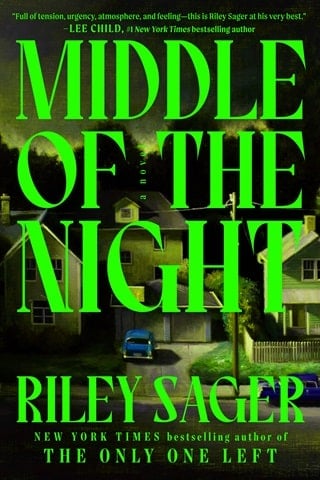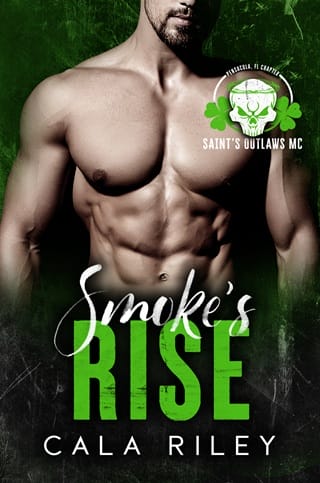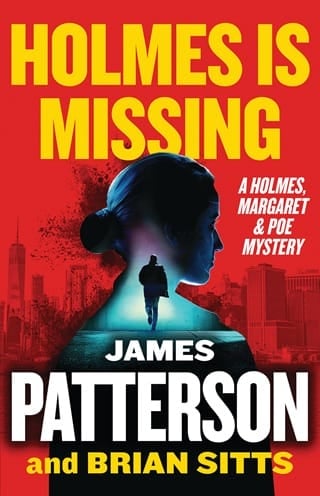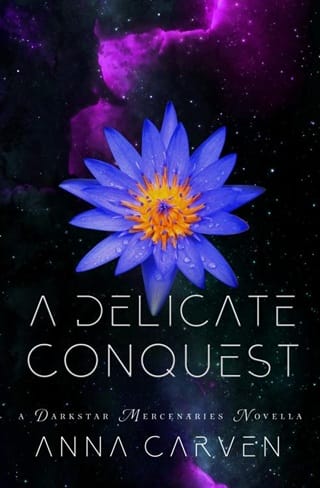Chapter Fifteen
After groggily going through the motions of normal life—coffee, breakfast, shower—I'm back at the laptop by nine a.m., this time examining Hemlock Circle as it looks on Google Maps. From above, it appears as a series of circles within circles, like a target.
The bull's-eye, if you will, is a small circular island of plants in the dead center of the cul-de-sac. There's a Japanese maple, some stubby evergreens, swaths of ivy. Surrounding it is the street itself, which juts into the circle between the Wallaces' and the Patels'. The outer circle is made up of the property lots—a thick band of green lawn on which sit six homes.
Surrounding all of it is the forest, which thins out a quarter mile behind the Wallace house, where it's replaced by a state road with another, less-wooded residential area on the other side. I move the map in the opposite direction, nudging it northward until the screen is filled with the green of the woods behind my house.
I don't stop until a brown rectangle breaks through the green.
The Hawthorne Institute.
At least I think it is. The land surrounding it is more overgrown than I remember it being, with swaths of pixelated green obscuring what resides there. Even when I zoom in, it's hard to make out individual buildings or other details. Almost as if it's forbidden to see them from any angle.
Or maybe I'm just so exhausted I can't see straight.
I barely slept a wink during the night, too occupied by thoughts of Billy, of ghosts, of Billy's ghost. Now I'm running only on fumes and caffeine as I stare at the satellite view of the area, trying in vain to bring it into focus.
One of the things that kept me awake all night was this idea that Billy needs me to help him move on. That he's spent the past thirty years in a ghostly limbo, waiting for my return. Since his remains were found there—and because it's where we went to explore the day he vanished—the falls and the Hawthorne Institute seem like the most logical place to start.
I return to my old friend Google, beginning my search with Ezra Hawthorne. For someone worth a billion dollars when he died, his digital footprint is shockingly small. The search yields just a few archival photos showing a man whose looks barely changed over the years. A picture of him taken in the sixties bears a striking resemblance to one snapped in the nineties. In all of them, his overriding feature is paleness. White hair, white skin, white teeth. When that's combined with the fact that he seemed only to have been photographed while wearing a black suit, a person couldn't be faulted for thinking Ezra was actually a walking corpse.
Yet he lived for almost a hundred years, according to his meager Wikipedia page. Born in 1900, died in 1998. And that's about it for pertinent information contained in his listing, which mostly details his status as the only child of Elsa Hawthorne, who was the only child of steel magnate L. B. Hawthorne. The institute is mentioned once, in a sentence so vague it could mean literally anything.
Hawthorne founded the Hawthorne Institute in 1937, and remained its head and primary benefactor until his death. It closed shortly thereafter.
There's no link to a separate entry for the institute, nor is there any hint of what went on there. The rest of the page is just Ezra Hawthorne's biography, outlined in brief snippets.
Education: Princeton University
Occupation: Philanthropist and philosopher
Personal life: Never married
Only under the entry for religion do things get interesting. There, it reads, "While Hawthorne never publicly affiliated himself with any organized religion, he was known to dabble in the occult."
That last word glows like neon on my laptop screen.
Occult.
A far cry from how Detective Palmer described Ezra Hawthorne. She merely called him eccentric and said that his institute was a place of research. But this makes it sound like it was something else.
Something sinister.
Then again, it might not be true at all. Wikipedia has given the sentence a "citation needed" tag, indicating there's nothing to back it up.
Yet the word "occult"—and all that it implies—sticks with me as I do another Google search, this time for the Hawthorne Institute. It yields hundreds of results. Very few are places in the United States. None are in New Jersey.
I search again, this time including the zip code. That brings up one entry: Hawthorne Farms.
I click it and am brought to a section of the county park system's website. At the top of the page is an image of what could pass for a royal estate in the British countryside. Walls of mountain stone, leaded windows, slate roof. And while the accompanying text makes no mention of an institute, I'm certain this is the place. I know because it says the mansion and grounds are available to rent for weddings and private functions, which Ragesh mentioned the other day. Apparently, dubbing it a farm is better for bookings than calling it an institute.
Lower on the page is a sampling of photos taken at such events. One shows a room filled with men in suits bearing a cadaverous appearance similar to Ezra Hawthorne's. Another pictures that same room decked out for a wedding. Beneath it is a photo of a bride and groom posing with the falls in the background. My stomach clenches when I see it.
Billy is in that photo.
Not visible.
Certainly not a shadow person lurking at the edges of ghostly mist hovering among the rushing water.
But he's there nonetheless. Just beneath the lake's surface. His presence known to no one.
I stare at the faces of the happy couple and wonder a hundred different things. Could they feel Billy's presence while smiling for the camera? Did they sense him the same way I do when I enter the backyard?
Unable to look at what's become of the place now, I resume my search for signs of what it used to be. Rather than futilely Google for a few more hours like I did last night, I remember how Claudia, in her work for a far different parks department, used a subscription-based newspaper archive whenever she needed to do a historical deep dive into one of the places she oversaw.
Five minutes and one credit card charge later, I'm scanning more than a century's worth of local newspapers, most of them long gone. The Hawthorne Institute yields several hits from the kind of hyperlocal weekly newspapers that used to flourish everywhere but barely exist nowadays. I choose one at random and see it's from late October 1963. A notice in the social calendar informing readers of upcoming events, in this case a lecture about Harry Houdini to be held on Halloween night for invited guests at the Hawthorne Institute. There is no follow-up article.
Most of the other search results are similar event listings or tersely innocuous recaps. "The Hawthorne Institute hosted the Amazing Kreskin at a private dinner on Saturday," reads one entry from 1972. "Hawthorne Institute holds annual meeting," goes another from 1985.
Among the most recent items are obituaries for Ezra Hawthorne, in which the institute is mentioned but dwarfed by flashier topics such as his family and his philanthropy. Not long after those are articles heralding his bequeathing of the institute's land to the county. Nearly all of them describe Ezra as "eccentric" or "reclusive" or, in one, "controversial," although, like Wikipedia's mention of the occult, there's nothing to support the statement. Just like there's nothing to suggest what really went on at the Hawthorne Institute and if anyone there would have had a reason to harm a ten-year-old boy.
That's where my mind keeps going, even though I agree with Russ that it makes me seem paranoid. Maybe I wouldn't feel this way if the institute grounds had been searched after Billy was taken. But they weren't, most likely because Ezra Hawthorne paid someone off. Since Billy's body was found there—and because I don't buy into Detective Palmer's theory that the killer was from Hemlock Circle—the only conclusion I can come to is that his murder was somehow related to our time at the Hawthorne Institute.
The big unknown about that day is Billy's whereabouts between the rest of us leaving the institute grounds without him and his arrival in my backyard later that evening. A span of more than five hours. I have no idea how long he was at the Hawthorne Institute or what he saw or who he talked to. He didn't share any details in the tent that night because he was mad at me and I was mad at him, and both of us, I suspect, were also angry at ourselves.
But if Billy's death is somehow related to being at the Hawthorne Institute, is it even possible that he could have seen or heard something he shouldn't have? I won't know until I see the place for myself.
Which means the next step is to go there. I'll likely discover nothing by retracing our steps to the institute and back, but that's not really the point. If Billy wants me to do it—and I'm pretty sure he does—I will. I owe him at least that much.
Before closing the website, I narrow the search to things published within a five-year window of Billy's abduction. A last-ditch attempt to learn something useful about the place during that time. I don't find much. The Hawthorne Institute's social calendar slowed noticeably in the nineties. Instead, I only see tiny mentions lumped in with others in listings of library donations and property tax assessments.
Exactly one item piques my interest, in a crime blotter from July 1992. Someone living near the institute filed a noise complaint, saying they heard a scream coming from the property in the middle of the night.
Because Hemlock Circle is the closest residential area to the institute, my guess is that the complaint came from here. I doubt my parents would have done it, even though we were firmly ensconced on the cul-de-sac by then. Besides, I think I'd remember hearing a scream from the woods when I was eight. Who made the complaint—and the source of the scream—remains unknown. The newspaper never bothered to follow up on it.
I assume that lack of detail will be evident in the news item immediately preceding it, from June of the same year. I give it a half-hearted scan, uninterested in a listing of places where local students have been assigned to do mandatory volunteer service. But then I see that the Hawthorne Institute was one of them—a revelation that brings a spike of adrenaline.
I'm hit with another when I read the very familiar names of the two students sent there.
Johnny Chen and Ragesh Patel.
While I'm not surprised the two of them did volunteer work—it was required, after all—I'm shocked that a place as secretive as the Hawthorne Institute took part in the program. Only once, it seems, because a search for mentions of it in similar listings from other years comes up empty.
That strikes me as odd.
Veryodd.
A private institute doing unknown research let two teenage boys volunteer there. Then it apparently never happened again. Making it weirder is the fact that Johnny died of a drug overdose the next summer. Even though one likely has nothing to do with the other, it does make me wonder what kind of work Johnny and Ragesh did at the Hawthorne Institute—and how much Ragesh really knows about the place.
Whatever it is, it's more than he's let on, both now and thirty years ago.
 Fullepub
Fullepub 



